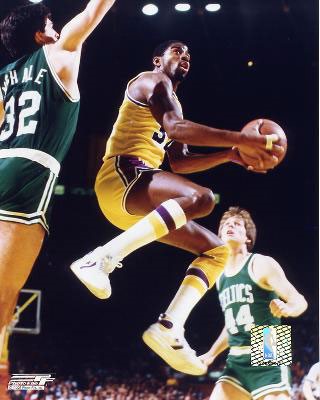T&W poet-in-residence Dave Johnson demonstrates how powerful imagery can (literally) move readers. This lesson on metaphor employs Quincy Troupe’s “A Poem for Magic” to engage and inspire young writers. Though written as a poetry lesson, Johnson’s lesson plan is equally suited to teaching the importance of detailed description found in all kinds of compelling writing.
Lesson Overview
Download: Magic Johnson Metaphors
Common Core State Standards:
(Refer to the Standards for English Language Arts > Writing > Grade 7 and English Language Arts > Reading: Literature > Grade 7)
- ELA-LITERACY.W.7.3.D
Use precise words and phrases, relevant descriptive details, and sensory language to capture the action and convey experiences and events. - ELA-LITERACY.RL.7.4
Determine the meaning of words and phrases as they are used in a text, including figurative and connotative meanings; analyze the impact of rhymes and other repetitions of sounds (e.g., alliteration) on a specific verse or stanza of a poem or section of a story or drama.
Guiding Questions:
- What is metaphor?
- What is image?
- How are they used to strengthen writing?

LESSON
Model/Mentor Text:
Read aloud “A Poem for Magic” by Quincy Troupe.
Select, or invite students to select, a few metaphors that describe the action. Ask students to physically stand up and show us what Magic is doing in the poem. Ask them, “Why does the speaker in the poem call Magic a Las Vegas card dealer? Why does he say he must have stork legs? What do these lines add to the poem? What else could they mean?”
Pre-writing Activity:
Ask students to brainstorm a list of possible metaphors that they might attribute to themselves. Remind them to keep in mind alternative meanings for their metaphors; e.g., Magic as a “spaceman.”
Ask students to create a list of people that they could write a poem to or for. Then make a list of things they like about what they do. And finally list things they could compare them to.
Example:
- Michael Jordan
- I like the way he dunks.
- When he dunks he sticks his tongue out like a dog.
Writing Activity:
Ask students to: Write your own poem. Open a poem speaking to the person you are writing for, addressing them directly. In each line, show us one thing they do from your list. And when you describe what they are doing that makes you so ecstatic, use a metaphor to describe their actions.
Ask students to trade papers with a fellow student/writer. As they read their partner’s poem, have them stand up and act out what they see in each line. Encourage students to consider what emotion they would attribute to each metaphorical line.
Now, invite them to write a new poem in response to their classmate’s. For example, if a student wrote a poem for a male vocalist, his or her partner’s response poem might be for a favorite female vocalist. If the student read a classmate’s poem about baseball, the response poem might be about ballet, etc.
Closing: Share!
Materials:
“A Poem for Magic,” by Quincy Troupe
Vocabulary:
Metaphor, description, quicksilver
Multimodal approaches to learning:
This lesson appeals to kinesthetic learners, as students physically create the images they read; interpersonal learners, as students read and respond to another’s work and see their own poetry reflected by a classmate; and intrapersonal learners, allowing time for independent writing and reflection.
